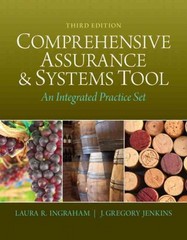Question
1 A Gross Profit Margin is: A measure of profitability that shows the percentage of revenue that exceeds the cost of goods sold (COGS) The
1 A Gross Profit Margin is:
A measure of profitability that shows the percentage of revenue that exceeds the cost of goods sold (COGS)
The ratio of net profits to revenues for a company or business segment
The income received by a company from its sales of goods or the provision of services
The absolute dollar amount of revenue that a company generates beyond its direct production costs
2 Menu engineering should consider (1) contribution margin, (2) popularity of a menu item and (3) customer demand.
Select one:
True
False
3 Which two components can the flexible budget variances be broken down into?
Price or cost variances and quantity variances
Labour cost variance and actual variable labour hours
The difference between the static budget and flexible budget
The actual price and the budgeted price
4 What does the supply and demand analysis show?
The number of each item sold per period
That there is a market for the business
How the company will pay for all the costs
The relevant and irrelevant costs
5 Net present value (NPV) and internal rate of return (IRR) are two capital budgeting methods.
True
False
6. How is the static budget variance calculated?
By finding the difference between the budgeted cost and actual cost
By multiplying the difference between direct labour hours and budgeted direct labour hours
By multiplying the difference between the actual price and the budgeted price
By finding the difference between the static budget and the actual results
7 The budgeted quantity used for:
The static budget
The actual sales volume
The budgeted cost
The budgeted labour
8 Value-based pricing is a method in which a business sets prices based on what competitors may charge for similar items.
Select one:
True
False
9 What does the residual (or salvage) value of an asset refer to?
The present value factor from the Present Value Factors of an Annuity table
The time value of money
The difference between the value of cash inflows and the value of cash outflows
The value that an asset can be sold for at the end of its useful life
10 Relevant costs are costs that differ between alternatives in a specific decision.
Select one:
True
False
Step by Step Solution
There are 3 Steps involved in it
Step: 1

Get Instant Access to Expert-Tailored Solutions
See step-by-step solutions with expert insights and AI powered tools for academic success
Step: 2

Step: 3

Ace Your Homework with AI
Get the answers you need in no time with our AI-driven, step-by-step assistance
Get Started


